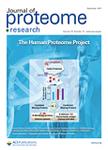版权所有:内蒙古大学图书馆 技术提供:维普资讯• 智图
内蒙古自治区呼和浩特市赛罕区大学西街235号 邮编: 010021

作者机构:Univ Michigan Med Ctr Dept Surg Ann Arbor MI 48109 USA Univ Michigan Med Ctr Dept Neurosurg Ann Arbor MI 48109 USA Univ Michigan Med Ctr Dept Cell & Dev Biol Ann Arbor MI 48109 USA Johns Hopkins Univ Baltimore MD 21205 USA Ist Nazl Neurol Carlo Besta Dept Neurosurg I-20133 Milan Italy Univ Milano Bicocca Dept Biosci & Biotechnol I-20126 Milan Italy
出 版 物:《JOURNAL OF PROTEOME RESEARCH》 (蛋白质组研究杂志)
年 卷 期:2010年第9卷第5期
页 面:2565-2572页
核心收录:
学科分类:0710[理学-生物学] 071010[理学-生物化学与分子生物学] 081704[工学-应用化学] 07[理学] 08[工学] 0817[工学-化学工程与技术]
基 金:National Institute of Health [R01 49500] National Cancer Institute [R21 CA134623] Accelerate Brain Cancer Cure Project Award American Brain Tumor Association Voices Against Brain Cancer Research Grant
主 题:glycoprotein biomarker lectin microarray glioblastoma stem-like cells LC-MS/MS
摘 要:Despite progress in the treatment of glioblastoma, more than 95% of patients suffering from this disease still die within 2 years. Recent findings support the belief that cancer stem-like cells are responsible for tumor formation and ongoing growth. Here a method combining lectin microarray and LC-MS/MS was used to discover the cell surface glycoprotein markers of a glioblastoma-derived stem-like cell line. Lectin microarray analysis of cell surface glycans showed that two galactose-specific lectins Trichosanthes kirilowii agglutinin (TKA) and Peanut agglutinin (PNA) could distinguish the stem-like glioblastoma neurosphere culture from a traditional adherent glioblastoma cell line. Agarose-bound TKA and PNA were used to capture the glycoproteins from the two cell cultures, which were analyzed by LC-MS/MS. The glycoproteins were quantified by spectral counting, resulting in the identification of 12 and 11 potential glycoprotein markers from the TKA and PNA captured fractions respectively. Almost all of these proteins were membrane proteins. Differential expression was verified by Western blotting analysis of 6 interesting proteins, including the up-regulated Receptor-type tyrosine-protein phosphatase zeta, Tenascin-C, Chondroitin sulfate proteoglycan NG2, Podocalyxin-like protein 1 and CD90, and the down-regulated CD44. An improved understanding of these proteins may be important for earlier diagnosis and better therapeutic targeting of glioblastoma.